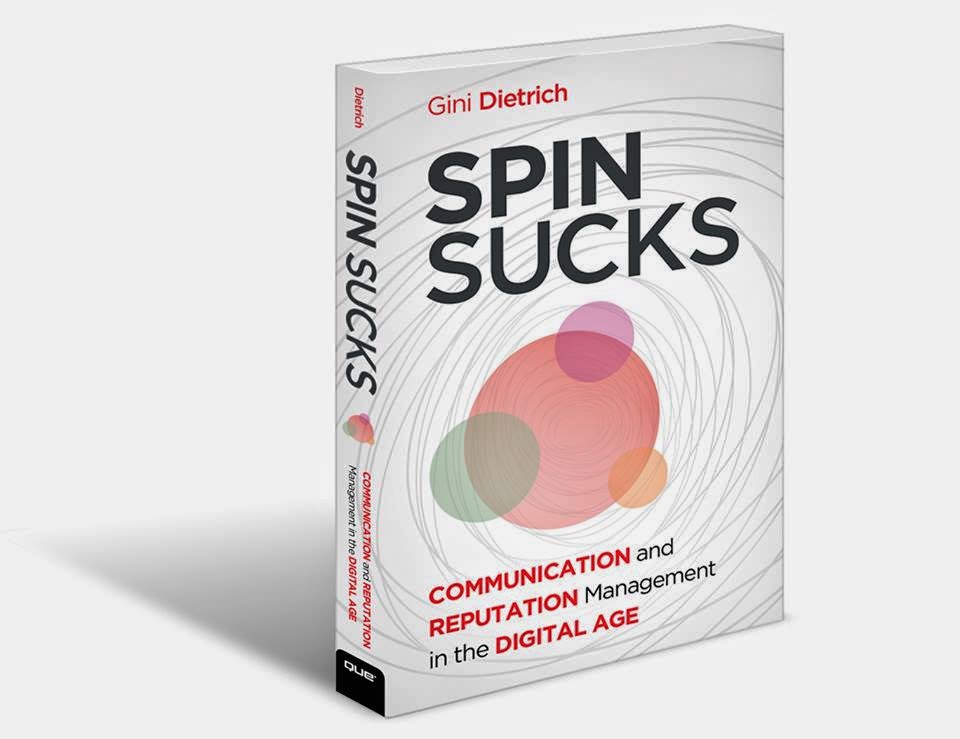 Need a reference point for public relations done right? If yes, read the new book Spin Sucks, Communications and Reputation Management in the Digital Age by public relations thought leader Gini Dietrich.
Need a reference point for public relations done right? If yes, read the new book Spin Sucks, Communications and Reputation Management in the Digital Age by public relations thought leader Gini Dietrich.
For several years, Dietrich has been a respected voice on how public relations / marketing needs to adapt within the new digital communications landscape through her Spin Sucks blog. I had the opportunity to read an advance copy of Spin Sucks the book and highly recommend it, especially for my colleagues within the higher education space. Here’s why I think the book is a good read for not only communicators, but also individual professors / thought leaders and higher education administrators.
Convergence of media
The book brilliantly describes how the media landscape has changed and how paid (advertising), earned (media), owned (content on your own channels) and shared media (social) have converged. If you are a professor looking to disseminate your research or expertise, then it is important to understand this media convergence. Ditto if you are an administrator responsible for marketing a particular aspect of a university or academic unit.
For communicators, Dietrich outlines the case for why we must not only be great storytellers, but also must understand the analytical side of marketing. This strikes a personal chord for me. I have always prided myself on delivering “free” visibility for the organizations I’ve worked for and the clients I represent. This hits on the owned, earned, and shared media aspects. In this past, I have shied away from paid media. Only recently I have made it a priority to learn more about paid advertising, particularly with the rise of native advertising. It is also important that I stay updated about analytics so proper metrics can be in place to judge the success of efforts in the owned, earned, paid and shared spaces.
Messaging
People can read spin from miles away. Dietrich points out the importance of transparency in communications. Messaging needs to be focused not on “you” and how great your organization is, but rather what it means for “them” – your readers.
Dietrich warns about the dangers of speaking French in your messaging. No, this doesn’t mean “Je parle franca is”, but rather is your messaging focused on the “we, we, we” perspective. The French needs to be replaced to instead focus on your different audiences.
Building community
In higher education, a big goal is to build communities. This might be internally, across an entire university, or amongst current students, prospective students or alumni, among others. The book gives readers a glimpse into the workings of the popular Spin Sucks blog and its vibrant community. There are many aspects of community engagement within Spin Sucks that can be replicated for individuals in higher education.
Crisis communication
While the content on crisis communications is an important for communicators, I think it is just as important that administrators read this content to understand the realities of digital communications and how to deal with crises in our social media world. Dietrich shares some interesting case studies and provides best practice.
Many academics have also learned the hard way about the harsh realities of unexpected digital crises. Case in point is professor Rachel Slocum at the University of Wisconsin. She sent an email to her students explaining an assignment. She provided a bit of personal opinion and in the process railed against Republicans over the government shutdown last year. She probably assumed this was quite innocuous. Little did she know that an offended student used this email as a rallying cry against liberal leaning professors. The email assignment message went viral. Spin Sucks offers a blue print on how to get out of such messes and also not to become a digital communications casualty in the first place.
Later this month, Gini Dietrich will be a guest on my podcast, For Immediate Release on Higher Education. We’ll discuss how she has been able to build her community and best practice for higher education communicators looking to do the same. Stay tuned!
